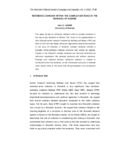| dc.contributor.author | Hambwe, John H | |
| dc.date.accessioned | 2014-12-09T12:12:48Z | |
| dc.date.available | 2014-12-09T12:12:48Z | |
| dc.date.issued | 2012 | |
| dc.identifier.citation | The University of Nairobi Journal of Language and Linguistics, Vol. 2 (2012), 79-88 | en_US |
| dc.identifier.uri | http://hdl.handle.net/11295/76899 | |
| dc.identifier.uri | https://linguistics.uonbi.ac.ke/basic-page/university-nairobi-journal-linguistics-and-languages | |
| dc.description.abstract | This paper focuses on reference cohesion within a complex sentence in
the day-to-day Kiswahili of Nairobi. The thrust of its argumentation is
that although earlier research inspired by Halliday and Hasan (1976) has
been of the view that higher discourse organization beyond the sentence
is the locus of cohesion, a Kiswahili complex sentence exhibits a
complex within-sentence cohesion structure that cannot be ignored.
Clauses in the Kiswahili complex sentence are tied and reinforced by
reference expressions like personal pronouns and relative pronouns.
Through such cohesive devices, reference cohesion is created or
reinforced within the sentence, as the information structure is revealed
more clearly while at the same time being expressed in an economical
way | en_US |
| dc.language.iso | en | en_US |
| dc.publisher | University of Nairobi | en_US |
| dc.subject | University of Nairobi Journal of Linguistics and Languages | |
| dc.title | Reference cohesion within the complex sentence in the Swahili of Nairobi | en_US |
| dc.type | Article | en_US |
| dc.type.material | en_US | en_US |


